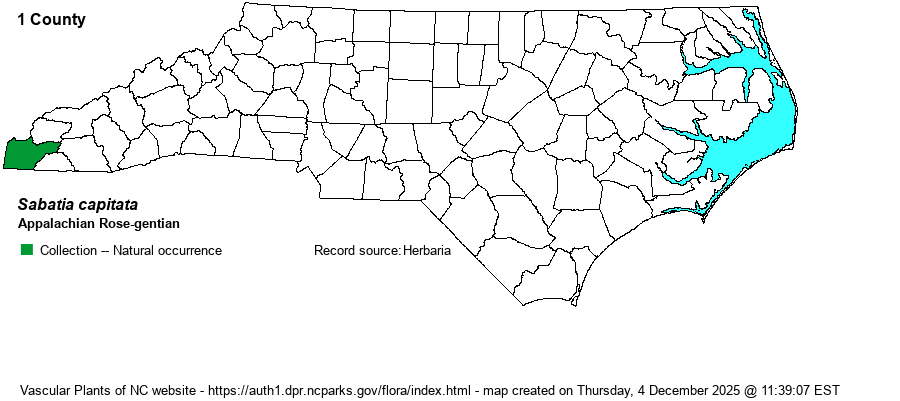| Author | (Rafinesque) S.F. Blake | |
| Distribution | An old specimen exists in the University of Georgia herbarium that is clearly this species, and stated on the label to be from North Carolina. Weakley (2018) says it is "a specimen collected 'from Cherokee', probably Cherokee County, NC, a remarkably poorly botanized area." The species does occur in southeastern TN and south throughout northwestern GA and south to central AL, and thus a record from Cherokee County, NC, adjacent to both of these states, is certainly plausible. Thus, the website editors are placing the record on the map below in Cherokee County (as does the BONAP map), despite a lack of corroboration of the county.
This species has a very tight and narrow range, essentially in the southern portions of the Cumberland Plateau and Ridge and Valley provinces -- from southeastern TN southwest to central AL, including northwestern GA and the isolated NC record for the far southwestern edge of the state. | |
| Abundance | Historical and possibly better called extirpated in NC. The NCNHP has rightfully placed the species on the Watch List as W3 (Rare but questionable documentation). Though the possible site is not overly far in distance from the edge of the main range, a record this old, without any newer records, suggests that a State Rank of SX (extirpated) is better. The NCNHP has routinely given a State Rank of SU (Undetermined) for nearly all of the W3 taxa. | |
| Habitat | This is a species of somewhat rocky, sandstone areas, near ledges, rocky slopes, and other fairly dry places such as wooded edges, including roadsides and meadows. |
| Phenology | Blooms from July to August, and fruits from September to October. | |
| Identification | This is a fairly tall species, with few branches, which tend to be quite erect, to about 2 feet high. The opposite leaves are lanceolate. The flowers grow mainly at the tips of the branches, as well as in upper leaf axils, and in this species there can be a few flowers in a tight cluster, though some may be solitary. There are often about 10 petals, which are bright rose-pink, with a spread flower often 1.5 inches across. The overall inflorescence is loose and tends to be quite vertical, with flowers at several "levels" along the upper part of the plant. This is quite a spectacular species when in full bloom and is obviously "unmissable" if encountered with flowers. | |
| Taxonomic Comments | None
| |
| Other Common Name(s) | Cumberland Rose-gentian | |
| State Rank | SU [SX] | |
| Global Rank | G2 | |
| State Status | W3 | |
| US Status | | |
| USACE-agcp | | |
| USACE-emp | | |

